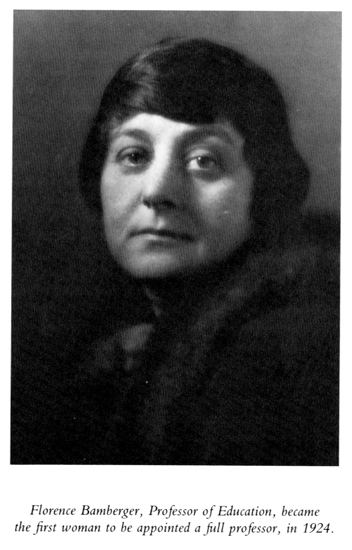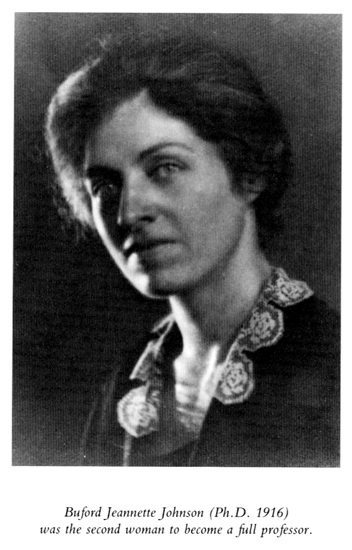|  |
Home > Collections > Rare Books and Manuscripts > Archives > Women at JHU: A History > Chapter 4
Fourteen years elapsed after the establishment of the School of Medicine before a policy change admitted women to the graduate programs of the Hopkins Faculty of Philosophy. The opening of the Woman’s College of Baltimore (Goucher) in 1888, with a curriculum closely patterned after that of Hopkins, provided the Trustees with a solution to the problem of women seeking undergraduate admission. Yet the same argument could not be made for the availability of graduate education in the Baltimore area. Yale, Brown, Columbia, and Harvard admitted women to graduate study in the 1890s, while Hopkins, usually the pioneer, trailed behind. 
Finally, on April 1, 1907, the Trustees approved the recommendation of Academic Council “that women who have taken the baccalaureate degree at institutions of good standing be admitted to graduate courses in this University, provided there is no objection on the part of the instructors concerned.” Three women graduate students entered in the autumn of 1907, and the first four women officially to take Hopkins doctorates did so on June 13, 1911. Their fields were Chemistry, Geology, German and Mathematics. These first women graduate students did not confine themselves to traditionally feminine fields, such as the humanities and education. During the first fifteen years, the greatest number of doctorates awarded to women was in Psychology (15, or 19%), followed by Mathematics (8 or 10%); over a third of the women took their degrees in the natural, physical or quantitative sciences. They also went on to prove their merits after graduation; of the sixty women who took Ph.D.s in the first thirteen years (1911-1924), seventy percent pursued academic careers.
Once women were admitted to the graduate programs, the next obstacle to surmount was representation on the Hopkins faculties. Women joined the all-male ranks slowly. Julia Anna Gardner became the second woman faculty member in the Faculty of Philosophy (after Christine Ladd-Franklin). Dr. Gardner was a geologist who had been among that first group of women to receive the doctorate in 1911 until 1917 and went on to work for the U.S. Geological Survey. The Medical School had been quicker to appoint women (often its own graduates) to the faculty, although they usually held low ranks, such as Assistant or Instructor. In 1898, Elizabeth Hurdon was made Assistant in Gynecology, followed by Florence R. Sabin (M.D. 1900), who became Assistant in Anatomy in 1902. Working her way up through the ranks, Sabin was appointed the first woman Professor in the School of Medicine in 1917. A statue of Dr. Sabin stands in the gallery at the U.S. Capitol, testimony to her contributions to the field of medicine. Once the College Courses for Teachers were established in 19009, more faculty positions for women opened up at Hopkins, as women were more accepted in the field of education. Opportunities arose also in the School of Hygiene and Public Health. Just a year after the School opened its doors in 1918, women comprised one-third of its faculty, albeit at the lowest ranks. |  |  | On March 4, 1924, Florence Eilau Bamberger became the first woman in the Faculty of Philosophy to be appointed a full professor. Dr. Bamberger had joined the faculty in 1916 as an instructor in education. She had taken her bachelor’s and master’s degrees at Columbia, where she also earned her doctorate in 1922 (studying under John Dewey); she did graduate work at Hopkins as well. While at Columbia, Bamberger had been active and ardent suffragette and became no less outspoken in expressing and defending her ideas on education. She was a frequent—and sometimes controversial—lecturer to both professional educational associations and community groups. In 1930, she succeeded Dr. Edward F. Buchner as Director of the College for Teachers and Chairman of the Department of Education in the Faculty of Philosophy. She served on the Hopkins faculty until she was made professor emeritus in 1947. Two months after Dr. Bamberger’s promotion to full professorship, Buford Jeannette Johnson became Professor of Psychology. These two women were, however, anomalies. A future Nobel Prize winner was among those women who suffered the effects of faculty hiring discrimination at Hopkins—and at other academic institutions as well. Maria Goeppert Mayer was the victim of nepotism rules (which forbade the employment of both spouses) as much as of sex discrimination. She came to Hopkins in 1930 with her husband, Joseph Mayer, who took up an appointment in the Chemistry Department. Because of his position, the Physics Department was able to offer his wife only a modest assistantship, which allowed her access to the University facilities, a place to work in the Physics Building, and the opportunity to participate in the scientific activities of the University. When Joseph Mayer moved on to Columbia, Maria met with similar professional hardship, and at the University of Chicago a nepotism rule again dictated that Maria could assume only a voluntary faculty position in the Institute for Nuclear Studies. It was not until 1946, at the Argonne National Laboratory, that she assumed a paid half-time position. At Chicago, Maria Mayer was one of a stellar assembly of physicists and chemists, which included Enrico Fermi, Harold Urey, Willard Libby and Edward Teller. Fermi and Joseph Mayer supported and encouraged her in her search for an explanation of atomic shell structure in terms of the quantum mechanics of the nuclear particles. She published at about the same time as J. Hans D. Jensen, and in 1951 the two began collaboration on further interpretation of this model. It was for this work that they were awarded the Nobel Prize in Physics in 1963, making Dr. Maria Goeppert Mayer the first woman residing in America to win a Nobel Prize in Physics, the second woman in history to win the Physics prize, and the third woman to receive the Nobel Prize in a science category.
Two Schools affiliated with Johns Hopkins in the second half of the twentieth century: the School of Advanced International Studies in 1950 and the Peabody Institute, Conservatory of Music in 1976. From its founding in 1857, Peabody has been coeducational. Women have always been an important part of the student body and faculty. In fact, in 1894 the Peabody Preparatory Department was established by a woman, May Garrettson Evans, a Conservatory alumna. Coeducation at the School of Advanced International Studies (SAIS) was more nominal until recent years. When the School opened in October 1944, more than half of its twenty-three students were women, because the war effort had so depleted the male student population. The percentage of women dropped off drastically right after the war but then steadily increased. In the mid-1960s, a concerted effort to recruit women students began, and between 1961 and 1973, the number of women tripled. Aside from language instructors and lecturers, SAIS had no women faculty members until 1972, when Ann Holick (M.A., 1966; Ph.D., Political Science, 1971) became Assistant Professor of American Foreign Policy. She taught courses in international relations, international resource management, and international science and technology policy and also set up the Ocean Policy Project (1972-78). She became an Associate Professor in 1975 and remained on the faculty until 1983. Joan Nelson organized the Department of Comparative Politics and Modernization and was made its Director in 1978, but she was denied tenure and the rank of professor in 1982. Grace Goodell succeeded her in January 1985 as Director of the program, renamed Social Change and Development, and entered with tenure at the Associate Professor level.
Statistics provide some interesting insights into the pattern of women’s enrollment in the various Hopkins schools over the years. In most of the divisions, the percentage of women remained relatively constant and low in the earliest years, but increased markedly during the First World War, peaking in academic year 1918-19. Presumably, women stepped in to fill the places in the University vacated by the men who joined the armed services. After the war, the percentages decreased, but not to the pre-war level. The percentage of women enrolled in the School of Medicine remained constant—and low—during the 1920s, but, in the Faculty of Philosophy and School of Hygiene, it rose steadily. Except in the School of Medicine, the Depression years saw a decline in the percentage of women enrolled. If funds were available for higher education, families were more likely to educate sons than daughters. Unfortunately, statistics are unavailable for the period from 1942 through 1946, so it is impossible to determine what impact the Second World War had on the enrollment of women. In the years immediately following the war, the percentage of women enrolled was about the same as during the 1930s, but it declined in the 1950s, a period when traditional roles for women were being reemphasized. In the Faculty of Philosophy, the percentage of women grew slowly beginning in the late 1950s. In the School of Medicine, however, the slump continued until the late 1960s. The School of Hygiene is an exception to this pattern of decline followed by slow growth, having had a constant and relatively large enrollment of women from the post-war years until the late 1960s. At this point, the percentage of women grew markedly in all the schools, most likely spurred by the impact of feminism on society in general. In the School of Hygiene, which always admitted a greater percentage of women that either the Faculty of Philosophy or School of Medicine, women began to outnumber men after 1978. Since engineering has long been a male-dominated field, the School of Engineering differed significantly in its enrollment patterns; it has been the Hopkins division with the lowest percentages of women enrolled over the years. From the available records, it appears that there were no graduate women in Engineering until 1949-50. From this time until 1967-68, when the School of Engineering merged with the Faculty of Philosophy to become the School of Arts and Sciences, there were never more than seven women enrolled in Engineering in any given year. After the G.W.C. Whiting School of Engineering was established in 1979, the percentage of graduate women enrolled grew significantly.
|  | The women who did graduate study at Hopkins generally went on to distinguish themselves in academic and other professional careers. One of the best known of these women was Rachel Carson. Carson took a master’s degree in zoology in 1932, and, beginning in 1936, she worked for the U.S. Fish and Wildlife Service as an aquatic biologist. She combined her first love—writing—with her fascination with the natural world and published Under the Sea Wind in 1941. She followed this with two best-sellers: The Sea Around Us (1951) and Silent Spring (1962). The latter set off a nationally publicized struggle between the proponents and opponents of the widespread use of pesticides. The book prompted President Kennedy’s Science Advisory Committee to undertake a study of the issue. Carson also appeared before the Senate Committee on Commerce, which was hearing testimony on the Chemical Pesticides Coordination Act and related bills. Rachel Carson was a quiet, mild yet firm crusader, whose efforts eventually led to the banning of DDT and more careful control of pesticides generally. Her work played an important role in catalyzing the environmental movement of the late 1960s. To Chapter 5 >> Women at JHU Index | Bibliography | Credits | |
|